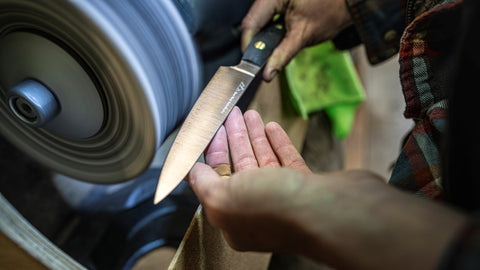The New West KnifeWorks factory in Victor, Idaho lies on the western face of the infamous Teton mountain range. In this factory, the American made heat treated steel is transformed into the beautiful, colorfully handled knives that are in your kitchen. Local makers handle the knives from start to finish at the shop.
Doing as much as possible in-house was always a long term goal of Corey Milligan's, but it took last year's move from a tiny factory in Jackson to a larger, more equipped factory in the neighboring town of Victor for his dream to be realized. More space, better equipment, and a bigger staff now allow for most of the knife making process to be handled in-house.
In this final installation of the How a Knife is Made series (read part one here and part two here), we take a look at the steps in the knife-making process that are done right here at home.
 Meet your makers! The New West knife-making team says hello from the Victor, Idaho factory.
Meet your makers! The New West knife-making team says hello from the Victor, Idaho factory.
When the steel first arrives from New York, it must be ground on both sides using abrasive belts backed by platens, which removes any horizontal inconsistencies in the steel. Then, the knives go through a Scotch-Brite machine which further softens any scratches or inconsistencies. Next, the knives are laser engraved with a fiber laser, which engraves "S35VN", "USA" and the New West KnifeWorks logo onto the steel.
 Proudly made in the USA! A knife goes through laser engraving.
Proudly made in the USA! A knife goes through laser engraving.
Then, the knives must be "laid up" with handle scales. Colorful yet NASA-grade indestructible G10 handles, which are made by putting layered fiberglass and epoxy under heat and high pressure, are applied to the steel. The handles are doubly secured with brass rivets while the epoxy is still soft. After the epoxy cures overnight, the knives go through a laborious, rigorous hand-grinding and hand-sharpening process. Each knife is checked by New West's head of production, Erin Hemmings, before it is ready to be sold.
 The knives and the handles are set and left overnight.
The knives and the handles are set and left overnight.
 Maker Ashley Childs rivets a G10 handle onto a knife.
Maker Ashley Childs rivets a G10 handle onto a knife.
 A knife gets a final pass with a spin jig and fine grit sanding belt.
A knife gets a final pass with a spin jig and fine grit sanding belt.
 Caution: extremely sharp! Each knife goes through a rigorous sharpening process.
Caution: extremely sharp! Each knife goes through a rigorous sharpening process.
Every maker in the shop is proficient in each step of the knife making process. So, once the steel arrives to the Victor factory, the knife that ends up in your kitchen has primarily been handled by one maker, who has seen the process through from initial grinding to final sharpening. The same is true for the knife blocks: each knife block is handled from start to finish in the Victor shop by a skilled maker.
 Knife block or work of art?
Knife block or work of art?
Knifemaker Morgan Keenan explains, "Every knife is a bit different and has a slightly different process." For example, the Santoku knife must pass through an electro-tech machine that uses positive/negative currents and salt water to remove a specific amount of steel from the knife, producing the aesthetic and functional (especially useful for slicing veggies) Teton Edge Santoku etching.
 A maker inspects the Teton Edge Santoku.
A maker inspects the Teton Edge Santoku.
In fact, head of production Erin Hemmings actually invented and built the serration machines that are used on all the New West knives, and has also innovated the Scotch-Brite machine and grinders. The Victor factory is a hotbed of creativity that all starts with American made steel. Stay sharp!

 Meet your makers! The New West knife-making team says hello from the Victor, Idaho factory.
Meet your makers! The New West knife-making team says hello from the Victor, Idaho factory. Proudly made in the USA! A knife goes through laser engraving.
Proudly made in the USA! A knife goes through laser engraving.
 The knives and the handles are set and left overnight.
The knives and the handles are set and left overnight.
 Maker Ashley Childs rivets a G10 handle onto a knife.
Maker Ashley Childs rivets a G10 handle onto a knife.
 A knife gets a final pass with a spin jig and fine grit sanding belt.
A knife gets a final pass with a spin jig and fine grit sanding belt.
 Caution: extremely sharp! Each knife goes through a rigorous sharpening process.
Caution: extremely sharp! Each knife goes through a rigorous sharpening process.
 Knife block or work of art?
Knife block or work of art?
 A maker inspects the Teton Edge Santoku.
A maker inspects the Teton Edge Santoku.